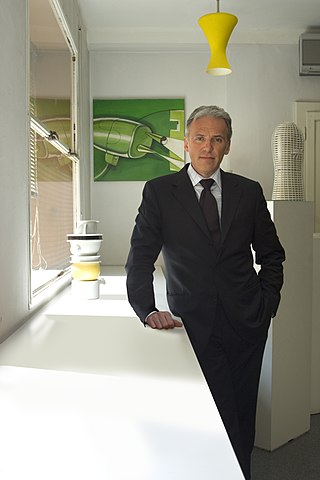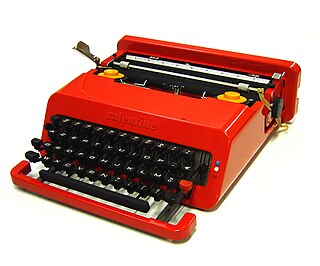Alessi is a housewares and kitchen utensil company in Italy, manufacturing and marketing everyday items authored by a wide range of designers, architects, and industrial designers — including Achille Castiglioni, Richard Sapper, Marco Zanuso, Alessandro Mendini, Ettore Sottsass, Wiel Arets, Zaha Hadid, Toyo Ito, Hani Rashid, Tom Kovac, Greg Lynn, MVRDV, Jean Nouvel, UN Studio, Michael Graves, and Philippe Starck. The Alessi company in the UK is worth around £2.4 million.

Ettore Sottsass was an Italian architect. He was notable for his furniture, jewellery, glass, lighting, homeware and office supply designs, as well as numerous buildings and interiors, often defined by bold colours.

Anna Maria Piaggi was an Italian fashion writer. She was known for her bright blue hair, liberal use of make-up, and her sense of style that mixed vintage and contemporary fashion.
Shiro Kuramata is one of Japan's most important designers of the 20th century.

Matteo Thun is an Italian architect and designer.
James Irvine was a British industrial designer who created furniture and product designs for many well known companies and brands such as Artemide, B&B Italia, Cappellini, Foscarini, Ikea, Magis, Muji, Thonet, and WMF. He once described the product designer's job as “the work of an unknown hero.”
George James Sowden is a British designer and product developer based in Milan.
Max Huber was an influential Swiss graphic designer.

Italian design refers to all forms of design in Italy, including interior design, urban design, fashion design, and architectural design. Italy is recognized as a worldwide trendsetter and leader in design. The architect Luigi Caccia Dominioni claimed, "Quite simply, we are the best. We have more imagination, more culture, and are better mediators between the past and the future". Italy today still exerts a vast influence on urban design, industrial design, interior design, and fashion design worldwide.
Jane Dillon, née Mary Jane Young is a British designer, educator and artist. She made significant contributions to furniture and Architectural lighting design across America and Europe. One of the few female international designers of her generation, Dillon's work encompassed contract and domestic furniture, lighting, textiles and glassware.

The Memphis Group, also known as Memphis Milano, was an Italian design and architecture group founded by Ettore Sottsass. It was active from 1980 to 1987. The group designed postmodern furniture, lighting, fabrics, carpets, ceramics, glass and metal objects.
Aldo Cibic is an Italian designer.
Clino Trini Castelli is an Italian industrial designer and artist. He has used the concept of "noform" throughout his work in environmental and industrial design, developed through the application of tools such as Design Primario and CMF design.
Nathalie Du Pasquier is a Milan-based artist and designer mostly known for her work as a founding member of the Memphis Group. Her early body of work includes furniture, textiles, clothing designs and jewelry in addition to iconic work in decoration and patterns. Since 1987, she has consistently dedicated herself to painting.

Massimo Iosa Ghini is an Italian architect, designer, and professor. He is recognized for his contribution to the Bolidist Movement and his involvement with the Memphis Group, alongside architects such as Ettore Sottsass and Michael Graves. Iosa Ghini is acclaimed for his streamlined and organic designs, demonstrating his visionary ability to blend disciplines, forms, and dimensions, transcending boundaries between art, design, and architecture. With a prolific career spanning the entire world, he has created numerous architectural projects and a substantial collection of furniture that reflects his futuristic design style. In 1990, he founded the Iosa Ghini Associati (Associates) Firm, which currently operates in Milan, Bologna, Moscow, and Miami.
Johanna Grawunder is an American architect, artist, and designer known for her work in lighting.
Studio Alchimia was a post-radical avant-garde group founded in Milan in 1976 by Alessandro Guerriero and his sister Adriana with the stated mission of "materializing a non-existent thing into being."

Eugenio Gerli was an Italian architect and designer. In an intense working life spanning more than six decades, Eugenio Gerli explored many different areas of his profession. He built villas, apartment blocks, office blocks, factories, banks and stores, and also restored historic buildings. He often completed his works with custom-made interiors and furniture.This diverse range of projects inspired his industrial design and today many have become icons, like the S83 chair, the PS 142 armchair Clamis, the Jamaica cabinet and the Graphis System.
Martine Bedin is a French architect and designer. She was a member of the Memphis Group.

The Olivetti Valentine is a portable, manual typewriter manufactured and marketed by the Italian company, Olivetti, that combined the company's Lettera 32 internal typewriter mechanicals with signature red, glossy plastic bodywork and matching plastic case. Designed in 1968 by Olivetti's Austrian-born consultant, Ettore Sottsass, who was assisted by Perry A. King and Albert Leclerc, the typewriter was introduced in 1969 and was one of the earliest and most iconic plastic-bodied typewriters.









